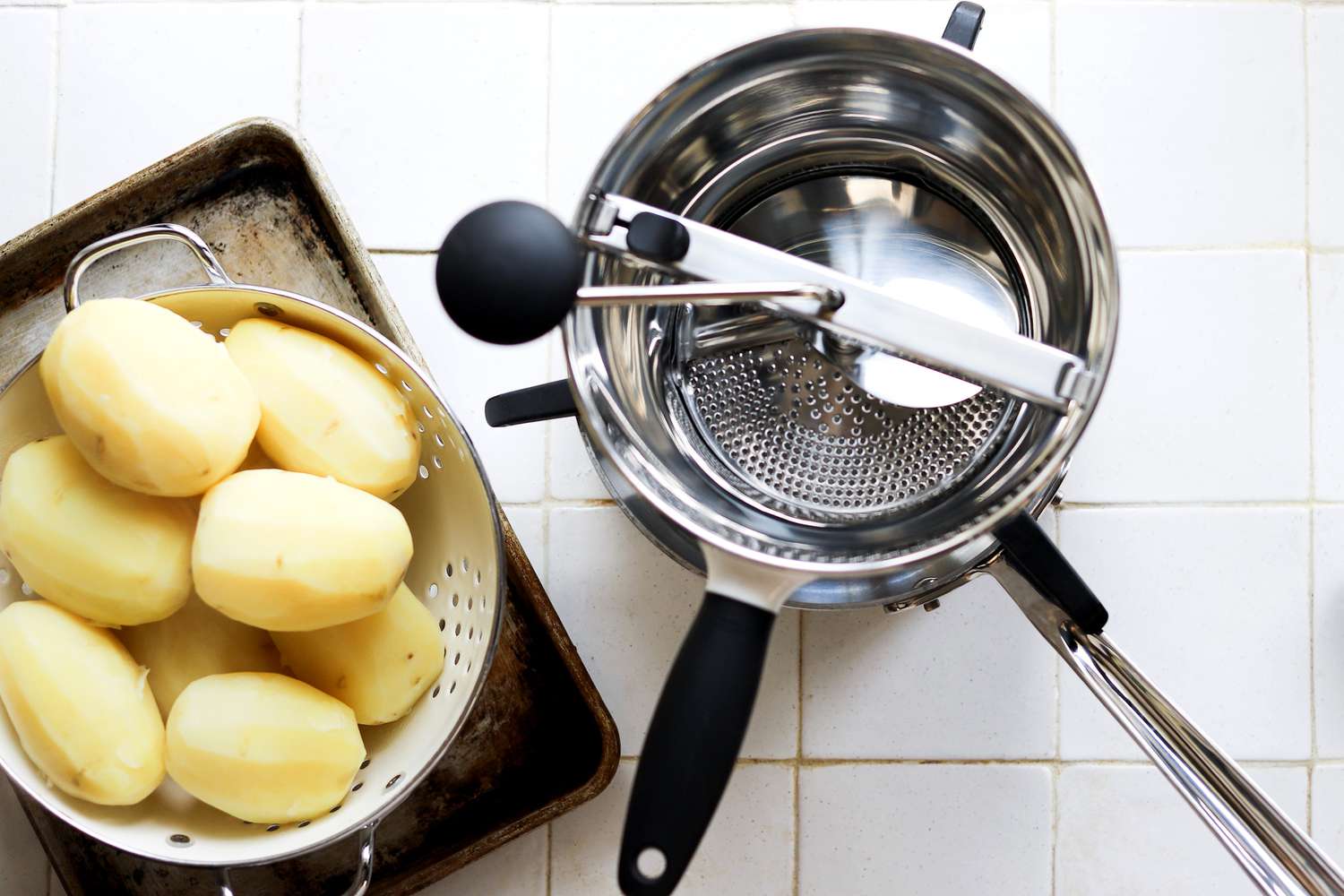
Straight to the Point
Our favorite food mill is the OXO Good Grips Stainless Steel Food Mill. It’s easy to use and makes silky smooth purees.
It’s hard to imagine the days before we had the convenience of electronic kitchen appliances. Mixers, food processors, and blenders all replaced tedious work done by hand. (Imagine making massive quantities of whipped cream manually! My wrist hurts just thinking about it.) But the food mill is one manual contraption that has stood the test of time.
This simple handheld device is used to make smooth purees and works by gently pressing ingredients through a sieve, resulting in something silky, but still textured. We’ve never formally reviewed them, so we tested nine mills, pureeing 20 pounds of potatoes and making batch after batch of fresh tomato sauce to find the best ones.
The Winners, at a Glance
This mill bested all others during our testing; it was easy to use, affordable, and produced great results. It pureed potatoes in a fraction of the time of other mills and the handle provided good leverage.
What this mill lacked in bells and whistles, it made up for in simplicity and ease, all while churning out good results. The sieve is fixed to the mill’s bowl, so you don’t have to fuss with tricky parts and rigid springs.
If you’re willing to spend more cash, this fancy mill has a few features that make it really easy to use. We liked the raised holes on the sieve which were more efficient at separating the tomato’s flesh from the skin, pulp, and seeds. The silicone-coated handle was also one of the most comfortable to hold and use.
The Tests
Serious Eats / Taylor Murray
- Creamy Mashed Potatoes Test: We made a batch of pommes puree, the French cousin of mashed potatoes, in each mill. We timed how long it took and noted ease of use, then tasted the final product to see if it was lumpy or if the processing created a gummy texture.
- Tomato Passata Test (Winners-Only): We used our favorite mills to make batches of tomato passata. This cooked tomato puree is a staple of Italian cooking and is free from skins and seeds. We evaluated how well the mill processed the mixture, separating the flesh from the rest, and how quickly it did so.
What We Learned
Fluted Sides Helped Funnel Ingredients
Serious Eats / Taylor Murray
Some of the mills we tested had straight sides, while others were fluted, like the OXO. Not only do fluted sides allow you to start with more food from the beginning (eliminating needing to stop and refill), but the slope also encourages food to move toward the perforated base. Straight-sided mills require you to use a spatula to encourage things downward.
Evenly Spaced, Raised Holes Made for Quicker Work
Serious Eats / Taylor Murray
Hole size directly impacts the texture of the final product, with smaller holes producing finer purees and larger ones allowing for a coarser texture. Additionally, the spacing between holes plays a crucial role in the efficiency of the milling process; closer spacing leads to a more uniform puree, while wider spacing can process larger quantities of food faster. Regardless of the size or shape of the holes, we found that food mills with raised holes, like on the Williams Sonoma, processed food much faster, likely because the raised design helps to prevent clogging and ensures a smoother, more consistent flow through the sieve.
The Best Food Mills Were Easy to Assemble
Serious Eats / Taylor Murray
If you’ve never used a food mill, you might not be aware of some of the finer points of setup. If you have, then you know that a model that’s easy to put together is crucial. For mills with changeable sieve plates, you first have to fit the sieve into the mill, which can be quite a task. Then, you have to take the crank lever and fit the post into the hole in the center of the sieve plate. Up the crank arm lies a spring topped by a crossbar. The crossbar has to be pushed down against the spring, swiveled slightly, and fit under two hooks that hold the crossbar in place. Some food mills, like the OXO, have a lock mechanism to ensure correct placement. Overcoming a stiff spring can make set up a challenge, but too little and the blade won’t push food into the mill well.
Handles and Stability Were Important, Too
Serious Eats / Taylor Murray
In addition to easy assembly, other things make a huge difference when it comes to the usability of a food mill, like its handles. Not only should they be comfortable to grab, but they should offer some leverage. Stay away from wire handles, which give little in the way of comfort.
Stability is another factor. Our winner, from OXO, has flat feet that rest on top of a bowl or pot and give you a greater range of options during use. Some mills use hooks to hang on the side of a pot, but, in general, this can be limiting. For example, if your food mill has hooks, an 8-inch bowl, and a 5-inch handle, you’re going to need to find a pot that’s pretty much exactly nine inches across to use with it.
Some of the mills we tested had hooks that were made of metal and others had ones coated with silicone or plastic. If we were going to go with hooks, we preferred the silicone-coated ones, which were better at gripping and slid around less.
The Criteria: What to Look for in a Food Mill
Serious Eats / Taylor Murray / Grace Kelly
Consider the size and capacity of the food mill. You’ll want one that’s big enough to handle the amount of food you plan to process but not so large that it’s difficult to store. Next, look at the materials: durable stainless steel is a great choice because it’s easy to clean and won’t rust. Some food mills come with interchangeable discs for different textures, from fine to coarse, which is handy for various recipes. That said, you want a mill that can quickly and easily puree; we liked mills with small raised holes, which produced the smoothest results. A comfortable handle and a stable base are a must, or else milling potatoes will feel like you’re wrangling a greased watermelon, with the mill slipping and sliding around. Ease of cleaning is also important; models that are dishwasher-safe or easy to disassemble will save you time and effort.
The Top Food Mills
What we liked: This has been a Serious Eats staff favorite for a while, and during our testing, we found out why. Unlike all the other food mills we tested, the OXO has silicone-covered feet that splay out flat and level, which makes it versatile in terms of what bowls or pots you can set it over. You can even set it on a flat surface and use it that way, while many of the others can’t rest flat on their bottom. The collapsible feet make it easy to store, as well.
The OXO created silky potato puree without gumminess and a smooth tomato passata that was neither too chunky nor too watery. It comes with your choice of three sieve discs so you can select the right one for the ingredient you want to process.
What we didn’t like: It did take a smidge longer to process the potatoes in this mill. However, when it came to things like the tomato passata, the texture of the final product was far superior (read: luscious and smooth).
Key Specs
- Material: Stainless steel
- Stated capacity: 2.3 quarts
- Discs included: 3
- Weight: 2 lbs, 5 ounces
- Handle length: 5 inches
- Opening diameter: 8 inches
- Care instructions: Dishwasher-safe
Serious Eats / Taylor Murray
What we liked: It’s hard not to like a food mill that comes at such a great price, but it has more going for it than saving you a few bucks. Unlike many others, this mill has a fixed sieve, meaning it only has one option for the size and shape of the holes at the bottom. Luckily, that one size is all you need for the majority of recipes. Another bonus of the fixed sieve is that you don’t have to fuss and fiddle with a stiff spring or wonky crossbar.
Like the Williams Sonoma, the Mirro also has a small metal stick that turns around the bottom of the sieve to scrape off processed food and prevent clogs, which was a handy feature that helped food pass through faster.
What we didn’t like: The other side of the coin with a fixed sieve is that you have no options when it comes to adjusting the amount of puree or seeds you want to pass through; what comes standard is just what you get. The straight sides meant we had to help push the food down periodically as well.
Key Specs
- Material: Stainless steel
- Stated capacity: 2 or 3.5 quarts
- Discs included: 1, fixed
- Weight: 1 lb, 5 ounces
- Handle length: 6 inches
- Opening diameter: 7 1/4 inches
- Care instructions: Hand-wash
Serious Eats / Taylor Murray
What we liked: The silicone-coated handles were very comfortable to hold (even though they were shorter than others), which offered more leverage when working the mill. Plus, the knob that spins the crank is oval instead of round, which was easier to get a firm grip on. The mill pureed food quickly and easily, and it was a breeze to set up.
It comes with a special clip that attaches to the base and rotates with the blade to scoop off processed food into your bowl of pot, preventing clogs and making things run smoothly. Some of the other higher-end food mills performed similarly well, but this was the most affordable of that group.
What we didn’t like: This mill is definitely on the pricier side.
Key Specs
- Material: Stainless steel, silicone-coated handles
- Stated capacity: NA
- Discs included: 3
- Weight: 2 lbs, 10 ounces
- Handle length: 4 1/2 inches
- Opening diameter: 8 1/4 inches
- Care instructions: Dishwasher-safe
Serious Eats / Taylor Murray
The Competition
FAQs
What’s a food mill good for?
A food mill is a great tool for any recipe or cooking project where you need to puree and strain simultaneously. With a food mill, you can effortlessly make silky-smooth tomato sauce free of seeds and skins, perfect for pasta dishes or pizza. It’s also fantastic for creating lump-free mashed potatoes, velvety applesauce, and smooth purees, such as pumpkin or squash. A food mill can also assist in making homemade jams, jellies, and fruit preserves by removing unwanted seeds and fibers, ensuring a smooth consistency. Its ability to separate solids from liquids without incorporating air makes it better suited than blenders or food processors for certain tasks.
What’s the best way to clean a food mill?
Cleaning your food mill right away will make the process easier. Most food mills are dishwasher-safe, but check the manufacturer’s instructions first. If washing by hand, disassemble the mill and wash each part with warm, soapy water. Use a brush to remove any food particles stuck in the sieve holes. Dry the parts thoroughly before reassembling them to prevent rust, especially if the mill is made of metal.
How is a food mill different from a ricer?
A food mill and a ricer both have metal sieves with holes—but they differ in how they process foods. A ricer uses a metal tamper to crush food through the holes in one swift motion, while a food mill has a handle and spinning metal piece that slowly pushes food through the sieve. Food mills are often used for purees and silky smooth mashed potatoes, while ricers are mainly used for crushing starchy foods, yielding a fluffier texture.
How do you use a food mill for tomatoes?
People often use food mills to make passata, a tomato puree that’s thin and fresh. In our recipe for passata, we have you quickly cook chopped fresh tomatoes to get rid of some water, then place them in the food mill and start turning. The food mill pushes the tomatoes through the metal sieve, capturing seeds and tomato skin.
Why We’re the Experts
- Taylor Murray has been working in food and food media for over 10 years, including in award-winning restaurants.
- She has written extensively for Serious Eats, including pieces on paella pans, carving boards, and more.
- She tested 10 stainless steel food mills by using them to puree 20 pounds of potatoes and make batches of passata. Throughout testing, she evaluated each model’s performance, usability, and design.
:max_bytes(150000):strip_icc()/OXO-Good-Grips-Food-Mill-73475816bbb14bf78d265eef2597060e.jpg)
:max_bytes(150000):strip_icc()/mirro-foley-stainless-steel-healthy-food-mill-ed52347718fb4e29ad46f440a8571399.jpg)
:max_bytes(150000):strip_icc()/williams-sonoma-prep-tools-food-mill-f06b9feb5356487da7a902c012d9c52e.jpg)





